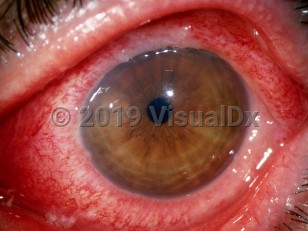Bacterial conjunctivitis - External and Internal Eye
Alerts and Notices
Important News & Links
Synopsis

Bacterial conjunctivitis is much less common than viral or allergic conjunctivitis in adults. Children and people with chronic ocular conditions tend to be more prone to bacterial conjunctivitis.
Patients will typically complain of ocular irritation, redness, foreign body sensation, and tearing associated with increased discharge. Itching is less common in bacterial conjunctivitis.
Inoculation of the conjunctiva is usually by direct hand-eye contact or can be due to direct spread of organisms located in the patient's own nasal passageway or sinuses. Often, patients will have concurrent sinus disease, upper respiratory infection (URI), or infectious dacryocystitis (infection of the lacrimal sac).
The onset of symptoms is usually over days to weeks but can be as short as 24 hours (hyperacute) or as long as years (chronic conjunctivitis). Hyperacute conjunctivitis is typically caused by Neisseria gonorrhoeae, and chronic conjunctivitis is typically caused by Chlamydia trachomatis or Staphylococcus associated with blepharitis. Acute forms of bacterial conjunctivitis are the most common manifestations associated with the diagnosis.
Note: As of August 25, 2023, the US Food and Drug Administration (FDA) is reminding the public that these recalled products should not be used due to potential bacterial contamination: EzriCare Artificial Tears, Delsam Pharma Artificial Tears, and Delsam Pharma Artificial Ointment. As of November 2023, the FDA is warning consumers not to purchase or use certain eye drops from several major brands due to risk of eye infection. Refer to the FDA list for more information. As of January 31, 2024, the FDA is warning consumers not to purchase or use South Moon, Rebright, or FivFivGo eye drops because of the potential risk of eye infection; these are copycat products easily mistaken for Bausch + Lomb's Lumify brand eye drops (an over-the-counter product approved for redness relief).
Patients will typically complain of ocular irritation, redness, foreign body sensation, and tearing associated with increased discharge. Itching is less common in bacterial conjunctivitis.
Inoculation of the conjunctiva is usually by direct hand-eye contact or can be due to direct spread of organisms located in the patient's own nasal passageway or sinuses. Often, patients will have concurrent sinus disease, upper respiratory infection (URI), or infectious dacryocystitis (infection of the lacrimal sac).
The onset of symptoms is usually over days to weeks but can be as short as 24 hours (hyperacute) or as long as years (chronic conjunctivitis). Hyperacute conjunctivitis is typically caused by Neisseria gonorrhoeae, and chronic conjunctivitis is typically caused by Chlamydia trachomatis or Staphylococcus associated with blepharitis. Acute forms of bacterial conjunctivitis are the most common manifestations associated with the diagnosis.
Note: As of August 25, 2023, the US Food and Drug Administration (FDA) is reminding the public that these recalled products should not be used due to potential bacterial contamination: EzriCare Artificial Tears, Delsam Pharma Artificial Tears, and Delsam Pharma Artificial Ointment. As of November 2023, the FDA is warning consumers not to purchase or use certain eye drops from several major brands due to risk of eye infection. Refer to the FDA list for more information. As of January 31, 2024, the FDA is warning consumers not to purchase or use South Moon, Rebright, or FivFivGo eye drops because of the potential risk of eye infection; these are copycat products easily mistaken for Bausch + Lomb's Lumify brand eye drops (an over-the-counter product approved for redness relief).
Codes
ICD10CM:
H10.89 – Other conjunctivitis
SNOMEDCT:
128350005 – Bacterial conjunctivitis
H10.89 – Other conjunctivitis
SNOMEDCT:
128350005 – Bacterial conjunctivitis
Look For
Subscription Required
Diagnostic Pearls
Subscription Required
Differential Diagnosis & Pitfalls

To perform a comparison, select diagnoses from the classic differential
Subscription Required
Best Tests
Subscription Required
Management Pearls
Subscription Required
Therapy
Subscription Required
References
Subscription Required
Last Reviewed:08/25/2019
Last Updated:02/15/2024
Last Updated:02/15/2024
 Patient Information for Bacterial conjunctivitis - External and Internal Eye
Patient Information for Bacterial conjunctivitis - External and Internal Eye
Premium Feature
VisualDx Patient Handouts
Available in the Elite package
- Improve treatment compliance
- Reduce after-hours questions
- Increase patient engagement and satisfaction
- Written in clear, easy-to-understand language. No confusing jargon.
- Available in English and Spanish
- Print out or email directly to your patient
Upgrade Today


